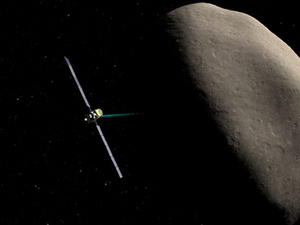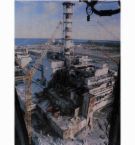MOSCOW - On the day of the 150th anniversary of the birth of Eduard Tsiolkovsky, the founder of world cosmonautics, scientists meet in Kaluga to discuss matters aimed at protecting the Earth from asteroids.
NASA has confirmed the launch date for Dawn, its mission to the asteroid belt. The space agency is aiming for a launch window that opens at 07:25 (EDT) on 26 September, and closes again 29 minutes later.

|
| ©n/a
|
| Artist's impression of Dawn flying past the dwarf-planet Ceres.
|
An Lu
XinhuaWed, 19 Sep 2007 09:14 UTC
An international team of astronomers has discovered that Neptune's south pole is much hotter than the rest of the planet, NASA's jet propulsion laboratory (JPL) reported Tuesday.

|
| ©NASA/JPL-Caltech
|
| An international team of astronomers has discovered that Neptune's south pole is much hotter than the rest of the planet.
|
A former senior aerospace engineer at Boeing's Phantom Works research unit, fired last year under disputed circumstances, is going public with concerns that the new 787 Dreamliner is unsafe.
Forty-six-year veteran Vince Weldon contends that in a crash landing that would be survivable in a metal airplane, the new jet's innovative composite plastic materials will shatter too easily and burn with toxic fumes. He backs up his views with e-mails from engineering colleagues at Boeing and claims the company isn't doing enough to test the plane's crashworthiness.
Boeing vigorously denies Weldon's assertions, saying the questions he raised internally were addressed to the satisfaction of its technical experts.
Ukraine is to cover the site of the Chernobyl nuclear reactor with a vast metal shelter in a long overdue operation designed to prevent the further leak of deadly radiation.

|
| ©Unknown
|
| Chernobyl Facility
|
Comment:

|
| ©Unknown
|
* Birth Defects: Five years after the disaster, the Ukrainian Ministry of Health reported three times the normal rate of deformities and developmental abnormalities in newborn children, as well as an increased number of miscarriages, premature births, and stillbirths.
* Other Cancers: Swiss Medical Weekly recently published findings showing a 40% increase in all kinds of cancers in Belarus between 1990 and 2000. (5) Tumor specialists fear that a variety of new cancers will only emerge 20-30 years after the disaster. (6) Cases of breast cancer doubled between 1988 and 1999.
* Other Diseases in Children: In addition to thyroid cancer and leukemia, UNICEF reports that between 1990 and 1994, nervous system disorders increased by 43%; cardiovascular diseases by 43%; bone and muscle disorders by 62%; and diabetes by 28%. UNICEF cautioned that it is difficult to prove whether these increases were caused by radiation or another unknown factor.
* Soil: Twenty-one percent of prime Belarusian farmland remains dangerously contaminated from the decaying components of plutonium.
* Groundwater: Radiation concentrated in sediments at the bottoms of lakes and ponds - the population continues to contaminate itself by fishing there. The average concentration of radionuclides in the groundwater has risen 10- to 100-fold.
* Food: The food and water supply is continuously contaminated by rainfall and by the movement of radioactive dust. Mushrooms - a national disk of Belarus - are severely contaminated in half the country but still collected and eaten. Livestock such as cattle and goats accumulate radioactivity in their meat and milk.
* Loss of a Culture: After the Chernobyl accident, almost 400,000 were forced to leave their homes for their own safety - homes and villages that had been part of their families for generations. Over 2,000 towns and villages were bulldozed to the ground, and hundreds more stand eerily silent.
For two generations of physicists, it has been a standard belief that the neutron, an electrically neutral elementary particle and a primary component of an atom, actually carries a positive charge at its center and an offsetting negative charge at its outer edge.
The notion was first put forth in 1947 by Enrico Fermi, a Nobel laureate noted for his role in developing the first nuclear reactor. But new research by a University of Washington physicist shows the neutron's charge is not quite as simple as Fermi believed.
Using precise data recently gathered at three different laboratories and some new theoretical tools, Gerald A. Miller, a UW physics professor, has found that the neutron has a negative charge both in its inner core and its outer edge, with a positive charge sandwiched in between to make the particle electrically neutral.
"Nobody realized this was the case," Miller said. "It is significant because it is a clear fact of nature that we didn't know before. Now we know it."
In about 30 of the world's deserts, the shifting sands create a booming noise that has baffled scientists for decades.
Early explorers imagined the strange rumbling sounds - roughly an octave and a half below middle C - as the cries of a buried horseman, or the bells of an underground convent.
Others have described it as the sound of musical instruments, or the drone of an airplane. Exactly how it happens, though, has long been a mystery.

|
| ©Daily Mail
|
| Hot stuff: Ecowatts boss Paul Calver with the device
|
It sounds too good to be true - not to mention the fact that it violates almost every known law of physics.
But British scientists claim they have invented a revolutionary device that seems to 'create' energy from virtually nothing.
Their so-called thermal energy cell could soon be fitted into ordinary homes, halving domestic heating bills and making a major contribution towards cutting carbon emissions.
Jeanna Bryner
Space.comSun, 16 Sep 2007 15:29 UTC
Wobbles in the rotation of Mars swung the planet into about 40 extreme ice ages in the past 5 million years and allowed thick ice layers to remain far away from the poles, an astronomer says.
Various spacecraft have revealed evidence for ice ages on Mars. Around 4 million to 5 million years ago, precipitation events sent piles of snow and ice that accumulated around the ice caps. Nowadays, the only visible ice on Mars is the pair of polar caps. But in recent years, orbiting probes have found solid evidence for vast sheets of underground ice near the red planet's equator, at what scientists call mid-latitudes.
CSIROSun, 16 Sep 2007 15:00 UTC
In a fascinating piece of spare-time research, CSIRO Exploration & Mining scientist Dr Ryan Noble has found that chemical ingredients in these drinks, including weak organic acids, have the ability to dissolve weakly-bound metals into solution.
"When you mix the drinks with soil, acids dissolve some of the metals into solution, which can then easily be detected in routine laboratory analysis," Dr Noble said.


Comment:
* Birth Defects: Five years after the disaster, the Ukrainian Ministry of Health reported three times the normal rate of deformities and developmental abnormalities in newborn children, as well as an increased number of miscarriages, premature births, and stillbirths.
* Other Cancers: Swiss Medical Weekly recently published findings showing a 40% increase in all kinds of cancers in Belarus between 1990 and 2000. (5) Tumor specialists fear that a variety of new cancers will only emerge 20-30 years after the disaster. (6) Cases of breast cancer doubled between 1988 and 1999.
* Other Diseases in Children: In addition to thyroid cancer and leukemia, UNICEF reports that between 1990 and 1994, nervous system disorders increased by 43%; cardiovascular diseases by 43%; bone and muscle disorders by 62%; and diabetes by 28%. UNICEF cautioned that it is difficult to prove whether these increases were caused by radiation or another unknown factor.
* Soil: Twenty-one percent of prime Belarusian farmland remains dangerously contaminated from the decaying components of plutonium.
* Groundwater: Radiation concentrated in sediments at the bottoms of lakes and ponds - the population continues to contaminate itself by fishing there. The average concentration of radionuclides in the groundwater has risen 10- to 100-fold.
* Food: The food and water supply is continuously contaminated by rainfall and by the movement of radioactive dust. Mushrooms - a national disk of Belarus - are severely contaminated in half the country but still collected and eaten. Livestock such as cattle and goats accumulate radioactivity in their meat and milk.
* Loss of a Culture: After the Chernobyl accident, almost 400,000 were forced to leave their homes for their own safety - homes and villages that had been part of their families for generations. Over 2,000 towns and villages were bulldozed to the ground, and hundreds more stand eerily silent.